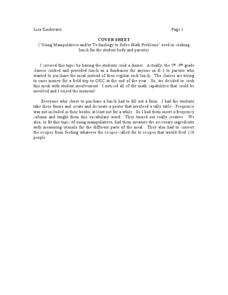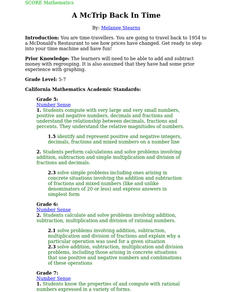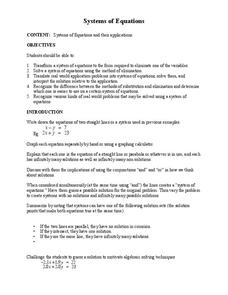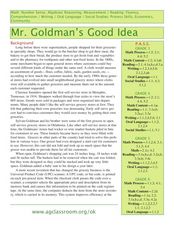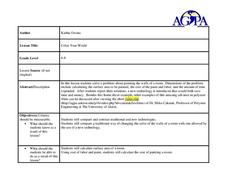Curated OER
Walk-a-thon
Fifth graders solve word problems. In this math lesson, 5th graders read the word problem and determine what is being asked. Students solve the problem and explain how they reached their solution.
Curated OER
Economics and emissions
Eighth graders produce a manufactured good and monitor energy consumption. In this Math instructional activity, 8th graders practice their basic math and accounting skills. Students participate in a business simulation.
Curated OER
Treats in a Basket
Students explore probability by participating in an experimental activity. In this number statistics activity, students collaborate in groups in which they move a game piece around a board. Students calculate their probability of landing...
Curated OER
"Using Manipulatives and/or Technology to Solve Math Problems" by Cooking Dinner
Students explore math functions by preparing a meal. In this food measurement lesson, students examine a recipe for a meal and alter the size of the recipe based upon the amount of servings needed. Students utilize manipulatives to...
Curated OER
A McTrip Back In Time
Students pretend they are time-travellers and travel back to 1954 to a McDonald's Restaurant to see how prices have changed. They need to add and subtract money with regrouping.
Visa
Home Sweet Home: Purchasing a Place
While the process of buying a home can certainly be overwhelming, give your young adults a leg up for their future by introducing them to the components of a mortgage, as well as exploring the basic concept of credit and how to become...
EngageNY
Using Expected Values to Compare Strategies
Discover how mathematics can be useful in comparing strategies. Scholars develop probability distributions for situations and calculate expected value. They use their results to identify the best strategy for the situation.
EngageNY
Conducting a Simulation to Estimate the Probability of an Event
How can you complete a simulation when it is not practical to determine the probability of an event? Class members learn that in some situations, it is not feasible to find the probability of an event, but they can estimate it by running...
Curated OER
Rounding and Estimation
Fifth graders participate in a lesson that is focused on rounding and estimating using word problems. They review how to read word problems, find the right operator, and use the new skills to solve problems.
Curated OER
Three-Digit Addition and Subtraction With Regrouping
Second graders access prior knowledge of addition and subtraction using two-digit numbers and calculate easily with them. In this three-digit addition lesson, 2nd graders learn to add and subtract three-digit numbers with and without...
Curated OER
Systems of Equations
Students solve systems of equations. In this algebra lesson, students use elimination and substitution to solve for the point of intersection. They use graphing to see where the two lines intersect.
Curated OER
It's About Time!
Students examine concept of time, and explore difference between analog and digital clocks; students make art project to represent time and create a time-story problem and solution.
EngageNY
Interpreting the Graph of a Function
Groups sort through NASA data provided in a graphic to create a graph using uniform units and intervals. Individuals then make connections to the increasing, decreasing, and constant intervals of the graph and relate these connections...
EngageNY
More Examples of Functions
Discrete or not discrete? Individuals learn about the difference between discrete and non-discrete functions in the fourth installment of a 12-part module. They classify some examples of functions as being either discrete or non-discrete.
Curated OER
Figuring Elapsed Time
Students tell time. In this elapsed time instructional activity, students review how to tell time to five minutes. Students solve problems where they must determine the elapsed time.
Curated OER
Comparing and Ordering Greater Numbers
Students compare and order greater numbers. In this place value lesson, students use a place-value chart to identify which set of numbers has the greatest value.
Curated OER
Comparing and Ordering Greater Numbers
Young scholars line up the digits of the numbers they are comparing in the correct manner. In this comparing numbers lesson, students learn to line numbers up correctly on a place value chart before comparing them. Young scholars then...
Curated OER
Mr. Goldman's Good Idea
Shopping carts are a modern convenience that many people take for granted. Make sure your pupils do not fall into that category by completing the activities in this plan. There are ideas included for language arts, social studies, math,...
Curated OER
Shell Sort; Serving up Seafood
Students complete various small group activities to classify items and determine the types of combinations that can be made with these items. In the second lesson, students create menus for a restaurant to help them gain money sense and...
Curated OER
Color Your World
Students calculate the cost of painting a room. In this surface area lesson, students create a scale model from provided dimensions of a bedroom. Groups use area formulas to find square footage, from which materials and labor costs are...
Curated OER
Energetic Citizenship
Middle schoolers analyze how to use less energy. In this energy conservation lesson, students discuss fluorescent and incandescent light bulbs and experiment to examine the energy of both sources using thermometers. Middle schoolers...
Curated OER
It's Your Future!
Learners explore the concept of getting a job and buying a home. In this getting a job and buying a home lesson, students research job qualifications and salaries for various jobs. Learners discuss what is a mortgage and how one works.
Curated OER
Figuring Elapsed Time
Students discover the concept of elapsed time. For this calculating time lesson, students utilize the Internet to complete record sheets based on the concept of elapsed time. Finally, the students answer questions on their own.
Curated OER
The Teenage Consumer
Students think critically regarding teenage spending. In this data collection lesson, students discuss teenage consumers and their spending habits. Students note their own spending habits for comparison purposes.
Other popular searches
- Money Math Lessons
- Counting Money Math Lessons
- Autism Money Math Lessons
- Shopping Money Math Lessons
- Math Lessons With Money
- Math Lessons on Money
- Money Math Lessons for Life





